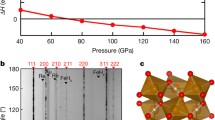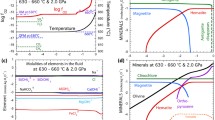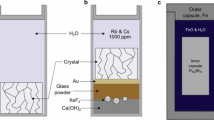Abstract
Oxidized fluids in the subduction zone may convert polyvalent elements in the mantle to their higher valence states. The most abundant polyvalent element in the mantle is Fe, a significant part of which is contained in olivine as Fe2+. Results of the study of arc mantle xenoliths, in lab high-pressure–high-temperature experiments, and thermodynamic modeling have shown that at pressures of ~ 50–2000 MPa and temperatures of 1000–1250 °C, well above the serpentine stability field, Fe2+ from olivine reacts with free aqueous fluid according to the following simplified reaction: 3Fe2SiO4 + 2H2O ⇆ 3SiO2 + 2Fe3O4 + 2H2. The resulting ferric iron is preserved in spinel of a certain composition, \(\left( {{\text{Mg,Fe}}_{{}}^{{2 + }} } \right){\text{Fe}}_{{2}}^{{3 + }} {\text{O}}_{{4}}\), whereas new high-Mg olivine, with magnesium number up to 96 in natural samples and 99.9 in experiments, forms in the reaction zone. SiO2 produced in the reaction either dissolves in the fluid or, with a small amount of water, reacts with olivine to form orthopyroxene as follows: (Mg,Fe)2SiO4 + SiO2 = (Mg,Fe)2Si2O6. The released H2 may decrease the oxidation state of polyvalent elements present in the fluid (e.g., S4+, S6+). Traces of high-temperature water–olivine interaction appear as swarms of fluid-spinel inclusions and are ubiquitous in olivine from ultramafic arc xenoliths. The described process is similar to serpentinization but occurs at higher pressure and temperature conditions and yields different reaction products. The reducing capacity of olivine is relatively low; however, given the large volume of mantle (and crustal) peridotites, the overall effect may be significant.















Similar content being viewed by others
References
Alt JC, Garrido CJ, Shanks WC, Turchyn A, Padrón-Navarta JA, López Sánchez-Vizcaíno V, Gómez-Pugnaire MT, Marchesi C (2012) Recycling of water, carbon, and sulfur during subduction of serpentinites: a stable isotope study of Cerro del Almirez, Spain. Earth Planet Sci Lett 327–328:50–60. https://doi.org/10.1016/j.epsl.2012.01.029
Andersen T, Neumann ER (2001) Fluid inclusions in mantle xenoliths. Lithos 55:299–318. https://doi.org/10.1016/S0024-4937(00)00049-9
Bakker RJ (2003) Package FLUIDS 1. Computer programs for analysis of fluid inclusion data and for modelling bulk fluid properties. Chem Geol 194:3–23. https://doi.org/10.1016/S0009-2541(02)00268-1
Ballhaus C (1993) Redox states of lithospheric and asthenosperic upper mantle. Contrib Miner Petrol 114:331–348. https://doi.org/10.1007/BF01046536
Barnes S-J, Roeder PL (2001) The range of spinel compositions in terrestrial mafic and ultramafic rocks. J Petrol 42:2279–2302. https://doi.org/10.1093/petrology/42.12.2279
Belonoshko AB, Shi P, Saxena SK (1992) Superfluid: a Fortran–77 program for calculation of Gibbs free energy and volume of C-H–O–N–S–Ar mixtures. Comput Geosci 18:1267–1269. https://doi.org/10.1016/0098-3004(92)90044-R
Bénard A, Klimm K, Woodland AB, Arculus RJ, Wilke M, Botcharnikov RE, Shimizu N, Nebel O, Rivard C, Ionov DA (2018) Oxidising agents in sub-arc mantle melts link slab devolatilisation and arc magmas. Nat Commun 9:1–10. https://doi.org/10.1038/s41467-018-05804-2
Berndt J, Liebske C, Holtz F, Freise M, Nowak M, Ziegenbein D, Hurkuck W, Koepke J (2002) A combined rapid-quench and H2-membrane setup for internally heated pressure vessels: description and application for water solubility in basaltic melts. Am Mineral 87:1717–1726. https://doi.org/10.2138/am-2002-11-1222
Brandon AD, Draper DS (1996) Constraints on the origin of the oxidation state of mantle overlying subduction zones: an example from Simcoe, Washington, USA. Geochim Cosmochim Acta 60:1739–1749. https://doi.org/10.1016/0016-7037(96)00056-7
Brandon AD, Draper DS (1998) Reply to the Comment by B.R. Frost and C. Ballhaus on “Constraints on the origin of the oxidation state of mantle overlying subduction zones: an example from Simcoe, Washington, USA.” Geochim Cosmochim Acta 62:333–335. https://doi.org/10.1016/S0016-7037(98)00009-X
Canil D, O’Neill HSC, Pearson DG, Rudnick RL, McDonough WF, Carswell DA (1994) Ferric iron in peridotites and mantle oxidation states. Earth Planet Sci Lett 123:205–220. https://doi.org/10.1016/0012-821X(94)90268-2
Churakov SS, Gottschalk M (2003) Perturbation theory based equation of state for polar molecular fluids: II Fluid mixtures. Geochim Cosmochim Acta 67:2415–2425. https://doi.org/10.1016/S0016-7037(02)01348-0
Clague DA (1987) Hawaiian xenolith populations, magma supply rates, and development of magma chambers. Bull Volcanol 49:577–587. https://doi.org/10.1007/bf01079963
Cottrell E, Birner S, Brounce M, Davis FA, Waters LE, Kelley KA (2021) Oxygen fugacity across tectonic settings. In: Neuville DR, Moretti R (eds) Redox variables and mechanisms in magmatism and volcanism: AGU geophysical monograph. Wiley, Hoboken. https://doi.org/10.1002/essoar.10502445.1
Demouchy S, Bolfan-Casanova N (2016) Distribution and transport of hydrogen in the lithospheric mantle: a review. Lithos 240–243:402–425. https://doi.org/10.1016/j.lithos.2015.11.012
Dohmen R, Becker HW, Chakraborty S (2007) Fe-Mg diffusion in olivine I: experimental determination between 700 and 1,200°C as a function of composition, crystal orientation and oxygen fugacity. Phys Chem Miner 34:389–407. https://doi.org/10.1007/s00269-007-0157-7
Duan Z, Møller N, Weare JH (1996) A general equation of state for supercritical fluid mixtures and molecular dynamics simulation of mixture PVTX properties. Geochim Cosmochim Acta 60:1209–1216. https://doi.org/10.1016/0016-7037(96)00004-X
Evans BW (2010) Lizardite versus antigorite serpentinite: magnetite, hydrogen, and life(?). Geology 38:879–882. https://doi.org/10.1130/G31158.1
Evans K, Elburg MA, Kamenetsky VS (2012) The oxidation state of sub-arc mantle. Geology 40:783–786. https://doi.org/10.1130/G33037.1
Frezzotti ML, Touret JLR (2014) CO2, carbonate-rich melts, and brines in the mantle. Geosci Front 5:697–710. https://doi.org/10.1016/j.gsf.2014.03.014
Frezzotti ML, Touret JLR, Lustenhouwer WJ, Neumann ER (1994) Melt and fluid inclusions in dunite xenoliths from La Gomera, Canary Islands: tracking the mantle metasomatic fluids. Eur J Mineral 6:805–817. https://doi.org/10.1127/ejm/6/6/0805
Frost BR, Ballhaus C (1998) Comment on “Constraints on the origin of the oxidation state of mantle overlying subduction zones: an example from Simcoe, Washington, USA” by A. D. Brandon and D. S. Draper. Geochim Cosmochim Acta 62:329–331. https://doi.org/10.1016/S0016-7037(98)00008-8
Frost DJ, McCammon CA (2008) The Redox State of earth’s mantle. Annu Rev Earth Planet Sci 36:389–420. https://doi.org/10.1146/annurev.earth.36.031207.124322
Harte B (1983) Mantle peridotites and processes - the kimberlite sample. In: Hawkesworth CJ, Norry MJ (eds) Continental basalts and their mantle xenoliths. Shiva Publishing Limited, Nantwitch, pp 46–91
Holland TJB, Powell R (1998) An internally consistent thermodynamic data set for phases of petrological interest. J Metamorph Geol 16:309–343. https://doi.org/10.1111/j.1525-1314.1998.00140.x
Holland TJB, Powell R (2011) An improved and extended internally consistent thermodynamic dataset for phases of petrological interest, involving a new equation of state for solids. J Metamorph Geol 29:333–383. https://doi.org/10.1111/j.1525-1314.2010.00923.x
Holloway JR, Dixon JE, Pawley AR (1992) An internally heated, rapid-quench, high-pressure vessel. Am Mineral 77:643–646
Houlier B, Cheraghmakani M, Jaoul O (1990) Silicon diffusion in San Carlos olivine. Phys Earth Planet Inter 62:329–340. https://doi.org/10.1016/0031-9201(90)90177-Y
Ionov DA (2010) Petrology of Mantle Wedge Lithosphere: New Data on Supra-Subduction Zone Peridotite Xenoliths from the Andesitic Avacha Volcano, Kamchatka. J Petrol 51:327–361. https://doi.org/10.1093/petrology/egp090
Jenner F, O’Neill HSC, Arculus RJ, Mavrogenes JA (2010) The magnetite crisis in the evolution of arc-related magmas and the initial concentration of Au, Ag and Cu. J Petrol 51:2445–2464. https://doi.org/10.1093/petrology/egq063
Kamenetsky VS, Zelenski M, Gurenko AA, Portnyagin MV, Ehrig K, Kamenetsky MB, Churikova T, Feig S (2017) Silicate-sulfide liquid immiscibility in modern arc basalt (Tolbachik volcano, Kamchatka): Part II Composition, magmatic assemblage and fractionation of the silicate melt. Chem Geol 471:92–110. https://doi.org/10.1016/j.chemgeo.2017.09.019
Kilinc A, Carmichael ISE, Rivers ML, Sack RO (1983) The ferric-ferrous ratio of natural silicate liquids equilibrated in air. Contr Mineral Petrol 83:136–140. https://doi.org/10.1007/BF00373086
Klimm K, Kohn SC, Botcharnikov RE (2012) The dissolution mechanism of sulphur in hydrous silicate melts. II: Solubility and speciation of sulphur in hydrous silicate melts as a function of fO2. Chem Geol 322–323:250–267. https://doi.org/10.1016/j.chemgeo.2012.04.028
Kohlstedt DL, Mackwell SJ (1998) Diffusion of hydrogen and intrinsic point defects in olivine. Z Phys Chem 207:147–162. https://doi.org/10.1524/zpch.1998.207.Part_1_2.147
Koloskov AV, Khotin MYu (1978) Ultramafic inclusions in lavas of the present-day Kamchatka volcanoes. In: Academy of Sciences of the USSR Soviet Geo-physical Committee (eds) Inclusions in the volcanic rocks of Kurile-Kamchatka island arc pp 33–66, Moscow, Nauka Publishing House (in Russian with English abstract)
Koloskov AV, Volynets ON, Ponomarev GP, Fedorov PI (1997) Ultramafic Xenoliths in Island-Arc volcanics of various geochemical type. Petrology 5:431–447
Kress VC, Carmichael ISE (1991) The compressibility of silicate liquids containing Fe2O3 and the effect of composition, temperature, oxygen fugacity and pressure on their redox states. Contr Mineral Petrol 108:82–92. https://doi.org/10.1007/BF00307328
Lesne P, Kohn SC, Blundy JD, Witham F, Botcharnikov RE, Behrens H (2011) Experimental simulation of closed-system degassing in the system basalt-H2O-CO2-S-Cl. J Petrol 52:1737–1762. https://doi.org/10.1093/petrology/egr027
Malaspina N, Poli S, Fumagalli P (2009) The oxidation state of metasomatized mantle wedge: Insights from C-O-H-bearing garnet peridotite. J Petrol 50:1533–1552. https://doi.org/10.1093/petrology/egp040
McCollom TM, Bach W (2009) Thermodynamic constraints on hydrogen generation during serpentinization of ultramafic rocks. Geochim Cosmochim Acta 73:856–875. https://doi.org/10.1016/j.gca.2008.10.032
Moine BN, Bolfan-Casanova N, Radu IB, Ionov DA, Costin G, Korsakov AV, Golovin AV, Oleinikov OB, Deloule E, Cottin JY (2020) Molecular hydrogen in minerals as a clue to interpret ∂D variations in the mantle. Nat Commun 11:3604. https://doi.org/10.1038/s41467-020-17442-8
Mungall JE (2002) Roasting the mantle: Slab melting and the genesis of major Au and Au-rich Cu deposits. Geology 30:915–918. https://doi.org/10.1130/0091-7613(2002)030<0915:RTMSMA>2.0.CO;2
Plyasunov AV, Bazarkina EF (2018) Thermodynamic properties of dilute hydrogen in supercritical water. Fluid Phase Equilibr 470:140–148. https://doi.org/10.1016/j.fluid.2017.11.004
Plyasunov AV, Korzhinskaya VS, O’Connell JP (2019) Correlation and prediction of thermodynamic properties of dilute solutes in water up to high T and P. I. Simple fluids He, Ne, Ar, Kr, Xe, Rn, H2, N2, O2, CO, CH4. Fluid Phase Equilibr 498:9–22. https://doi.org/10.1016/j.fluid.2019.06.012
Pons M-L, Debret B, Bouilhol P, Delacour A, Williams H (2016) Zinc isotope evidence for sulfate-rich fluid transfer across subduction zones. Nat Commun 7:13794. https://doi.org/10.1038/ncomms13794
Portnyagin MV, Almeev RR, Matveev S, Holtz F (2008) Experimental evidence for rapid water exchange between melt inclusions in olivine and host magma. Earth Planet Sci Lett 272:541–552. https://doi.org/10.1016/j.epsl.2008.05.020
Prausnitz JM, Lichtenthaler RN, de Avezedo EG (1999) Molecular thermodynamics of fluid-phase equilibria, 3rd edn. Prentice-Hall, New York, p 1245
Richards JP (2014) The oxidation state, and sulfur and Cu contents of arc magmas: implications for metallogeny. Lithos 233:27–45. https://doi.org/10.1016/j.lithos.2014.12.011
Roedder E (1979) Origin and significance of magmatic inclusions. Bull Minéral 102:487–510. https://doi.org/10.3406/bulmi.1979.7299
Rosso KM, Bodnar RJ (1995) Microthermometric and Raman spectroscopic detection limits of CO2 in fluid inclusions and the Raman spectroscopic characterization of CO2. Geochim Cosmochim Acta 59:3961–3975. https://doi.org/10.1016/0016-7037(95)94441-H
Sleep NH, Meibom A, Fridriksson T, Coleman RG, Bird DK (2004) H2-rich fluids from serpentinization: geochemical and biotic implications. Proc Natl Acad Sci 101:12818–12823. https://doi.org/10.1073/pnas.0405289101
Tollan P, Hermann J (2019) Arc magmas oxidized by water dissociation and hydrogen incorporation in orthopyroxene. Nat Geosci 12:667–671. https://doi.org/10.1038/s41561-019-0411-x
Tomkins AG, Evans KA (2015) Separate zones of sulfate and sulfide release from subducted mafic oceanic crust. Earth Planet Sci Lett 428:73–83. https://doi.org/10.1016/j.epsl.2015.07.028
Tomkins AG, Rebryna KC, Weinberg RF, Schaefer BF (2012) Magmatic sulfide formation by reduction of oxidized arc basalt. J Petrol 53:1537–1567. https://doi.org/10.1093/petrology/egs025
Ulmer P, Trommsdorff V (1995) Serpentine stability to mantle depths and subduction-related magmatism. Science 268:858–861. https://doi.org/10.1126/science.268.5212.858
Wagner W, Pruß A (2002) The IAPWS formulation for the thermodynamic properties of ordinary water substances for general and scientific use. J Phys Chem Ref Data 31:387–535. https://doi.org/10.1063/1.1461829
Wood BJ, Bryndzia LT, Johnson KE (1990) Mantle oxidation state and its relationship to tectonic environment and fluid speciation. Science 248:337–345. https://doi.org/10.1126/science.248.4953.337
Zhang Y (2008) Geochemical kinetics. Princeton University Press, Princeton, p 644
Acknowledgements
The initial period of this study benefited from insightful advice and comments from Maxim Portnyagin and Roman Botcharnikov. Comments from Dante Canil and Peter Tollan on the previous version of this article allowed us to reconsider the initial hypothesis and take a fresh look at the available materials. Detailed and valuable comments of the reviewers Jose Padron Navarta and Megan Eve Newcombe allowed us to significantly improve the second version of the article. We are also very grateful to our technician mechanic Nikolai Kuznetsov for technical support of the experimental work.
Funding
This work was funded by Russian Science Foundation (Grant no. 21-17-00122).
Author information
Authors and Affiliations
Corresponding author
Additional information
Communicated by Dante Canil.
Publisher's Note
Springer Nature remains neutral with regard to jurisdictional claims in published maps and institutional affiliations.
Supplementary Information
Below is the link to the electronic supplementary material.
Rights and permissions
About this article
Cite this article
Zelenski, M., Plyasunov, A.V., Kamenetsky, V.S. et al. High-temperature water–olivine interaction and hydrogen liberation in the subarc mantle. Contrib Mineral Petrol 177, 47 (2022). https://doi.org/10.1007/s00410-022-01910-z
Received:
Accepted:
Published:
DOI: https://doi.org/10.1007/s00410-022-01910-z




